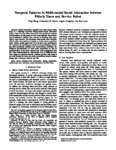Temporal patterns in multi-modal social interaction between elderly users and service robot
| dc.contributor.author | Wang, N | |
| dc.contributor.author | Di Nuovo, A | |
| dc.contributor.author | Cangelosi, Angelo | |
| dc.contributor.author | Jones, Ray | |
| dc.date.accessioned | 2022-02-08T17:16:46Z | |
| dc.date.available | 2022-02-08T17:16:46Z | |
| dc.date.issued | 2019-07-15 | |
| dc.identifier.issn | 1572-0373 | |
| dc.identifier.issn | 1572-0381 | |
| dc.identifier.uri | http://hdl.handle.net/10026.1/18725 | |
| dc.description.abstract |
<jats:title>Abstract</jats:title> <jats:p>Social interaction, especially for older people living alone is a challenge currently facing human-robot interaction (HRI). There has been little research on user preference towards HRI interfaces. In this paper, we took both objective observations and participants’ opinions into account in studying older users with a robot partner. The developed dual-modal robot interface offered older users options of speech or touch screen to perform tasks. Fifteen people aged from 70 to 89 years old, participated. We analyzed the spontaneous actions of the participants, including their attentional activities and conversational activities, the temporal characteristics of these social behaviours, as well as questionnaires. It has been revealed that social engagement with the robot demonstrated by older people was no different from what might be expected towards a human partner. This study is an early attempt to reveal the social connections between human beings and a personal robot in real life.</jats:p> | |
| dc.format.extent | 4-24 | |
| dc.language | en | |
| dc.language.iso | en | |
| dc.publisher | John Benjamins Publishing Company | |
| dc.subject | human-robot interaction | |
| dc.subject | ageing population | |
| dc.subject | multi-modal user interface | |
| dc.subject | social behaviours | |
| dc.subject | service robot | |
| dc.title | Temporal patterns in multi-modal social interaction between elderly users and service robot | |
| dc.type | journal-article | |
| dc.type | Journal Article | |
| plymouth.author-url | https://www.webofscience.com/api/gateway?GWVersion=2&SrcApp=PARTNER_APP&SrcAuth=LinksAMR&KeyUT=WOS:000478970200002&DestLinkType=FullRecord&DestApp=ALL_WOS&UsrCustomerID=11bb513d99f797142bcfeffcc58ea008 | |
| plymouth.issue | 1 | |
| plymouth.volume | 20 | |
| plymouth.publication-status | Published | |
| plymouth.journal | Interaction Studies | |
| dc.identifier.doi | 10.1075/is.18042.wan | |
| plymouth.organisational-group | /Plymouth | |
| plymouth.organisational-group | /Plymouth/Faculty of Health | |
| plymouth.organisational-group | /Plymouth/Faculty of Health/School of Nursing and Midwifery | |
| plymouth.organisational-group | /Plymouth/Faculty of Science and Engineering | |
| plymouth.organisational-group | /Plymouth/REF 2021 Researchers by UoA | |
| plymouth.organisational-group | /Plymouth/REF 2021 Researchers by UoA/UoA03 Allied Health Professions, Dentistry, Nursing and Pharmacy | |
| plymouth.organisational-group | /Plymouth/Research Groups | |
| plymouth.organisational-group | /Plymouth/Research Groups/Institute of Health and Community | |
| plymouth.organisational-group | /Plymouth/Research Groups/Marine Institute | |
| plymouth.organisational-group | /Plymouth/Users by role | |
| plymouth.organisational-group | /Plymouth/Users by role/Academics | |
| dc.identifier.eissn | 1572-0381 | |
| dc.rights.embargoperiod | Not known | |
| rioxxterms.versionofrecord | 10.1075/is.18042.wan | |
| rioxxterms.licenseref.uri | http://www.rioxx.net/licenses/all-rights-reserved | |
| rioxxterms.type | Journal Article/Review |


